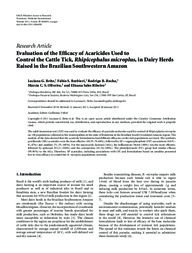Evaluation of the efficacy of acaricides used to control the cattle tick, Rhipicephalus microplus, in dairy herds raised in the Brasilian Southwestern Amazon.
Evaluation of the efficacy of acaricides used to control the cattle tick, Rhipicephalus microplus, in dairy herds raised in the Brasilian Southwestern Amazon.
Author(s): BRITO, L. G.; BARBIERI, F. da S.; ROCHA, R. B.; OLIVEIRA, M. C. de S.; RIBEIRO, E. S.
Summary: The adult immersion test (AIT) was used to evaluate the efficacy of acaricide molecules used for control of Rhipicephalus microplus on 106 populations collected in five municipalities in the state of Rondônia in the Brazilian South Occidental Amazon region. The analysis of the data showed that the acaricide formulations had different efficacies on the tick populations surveyed. The synthetic pyrethroids (SPs) acaricides were the least effective (48.35?76.84%), followed by SP + organophosphate (OP) associations (68.91?81.47%) and amidine (51.35?100%). For the macrocyclic lactones (MLs), the milbemycin (94.84?100%) was the most effective, followed by spinosad (93.21?100%) and the avermectins (81.34?100%). The phenylpyrazole (PZ) group had similar efficacy (99.90%) to the MLs. Therefore, SP acaricides, including associations with OP, and formulations based on amidine presented low in vitro efficacy to control the R. microplus populations surveyed.
Publication year: 2011
Types of publication: Journal article
Keywords: Acarides, Cattle tick, Control
Observation
Some of Embrapa's publications are published as ePub files. To read them, use or download one of the following free software options to your computer or mobile device. Android: Google Play Books; IOS: iBooks; Windows and Linux: Calibre.
Access other publications
Access the Agricultural Research Database (BDPA) to consult Embrapa's full library collection and records.
Visit Embrapa Bookstore to purchase books and other publications sold by Embrapa.

